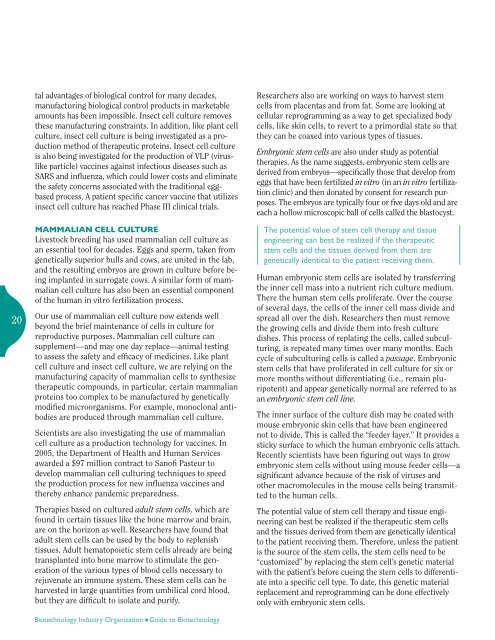Introduction Guide to Biotechnology - Biomolecular Engineering Lab
Introduction Guide to Biotechnology - Biomolecular Engineering Lab
Introduction Guide to Biotechnology - Biomolecular Engineering Lab
Create successful ePaper yourself
Turn your PDF publications into a flip-book with our unique Google optimized e-Paper software.
20<br />
tal advantages of biological control for many decades,<br />
manufacturing biological control products in marketable<br />
amounts has been impossible. Insect cell culture removes<br />
these manufacturing constraints. In addition, like plant cell<br />
culture, insect cell culture is being investigated as a production<br />
method of therapeutic proteins. Insect cell culture<br />
is also being investigated for the production of VLP (viruslike<br />
particle) vaccines against infectious diseases such as<br />
SARS and influenza, which could lower costs and eliminate<br />
the safety concerns associated with the traditional eggbased<br />
process. A patient specific cancer vaccine that utilizes<br />
insect cell culture has reached Phase III clinical trials.<br />
Mammalian Cell Culture<br />
Lives<strong>to</strong>ck breeding has used mammalian cell culture as<br />
an essential <strong>to</strong>ol for decades. Eggs and sperm, taken from<br />
genetically superior bulls and cows, are united in the lab,<br />
and the resulting embryos are grown in culture before being<br />
implanted in surrogate cows. A similar form of mammalian<br />
cell culture has also been an essential component<br />
of the human in vitro fertilization process.<br />
Our use of mammalian cell culture now extends well<br />
beyond the brief maintenance of cells in culture for<br />
reproductive purposes. Mammalian cell culture can<br />
supplement—and may one day replace—animal testing<br />
<strong>to</strong> assess the safety and efficacy of medicines. Like plant<br />
cell culture and insect cell culture, we are relying on the<br />
manufacturing capacity of mammalian cells <strong>to</strong> synthesize<br />
therapeutic compounds, in particular, certain mammalian<br />
proteins <strong>to</strong>o complex <strong>to</strong> be manufactured by genetically<br />
modified microorganisms. For example, monoclonal antibodies<br />
are produced through mammalian cell culture.<br />
Scientists are also investigating the use of mammalian<br />
cell culture as a production technology for vaccines. In<br />
2005, the Department of Health and Human Services<br />
awarded a $97 million contract <strong>to</strong> Sanofi Pasteur <strong>to</strong><br />
develop mammalian cell culturing techniques <strong>to</strong> speed<br />
the production process for new influenza vaccines and<br />
thereby enhance pandemic preparedness.<br />
Therapies based on cultured adult stem cells, which are<br />
found in certain tissues like the bone marrow and brain,<br />
are on the horizon as well. Researchers have found that<br />
adult stem cells can be used by the body <strong>to</strong> replenish<br />
tissues. Adult hema<strong>to</strong>poietic stem cells already are being<br />
transplanted in<strong>to</strong> bone marrow <strong>to</strong> stimulate the generation<br />
of the various types of blood cells necessary <strong>to</strong><br />
rejuvenate an immune system. These stem cells can be<br />
harvested in large quantities from umbilical cord blood,<br />
but they are difficult <strong>to</strong> isolate and purify.<br />
<strong>Biotechnology</strong> Industry Organization n <strong>Guide</strong> <strong>to</strong> <strong>Biotechnology</strong><br />
Researchers also are working on ways <strong>to</strong> harvest stem<br />
cells from placentas and from fat. Some are looking at<br />
cellular reprogramming as a way <strong>to</strong> get specialized body<br />
cells, like skin cells, <strong>to</strong> revert <strong>to</strong> a primordial state so that<br />
they can be coaxed in<strong>to</strong> various types of tissues.<br />
Embryonic stem cells are also under study as potential<br />
therapies. As the name suggests, embryonic stem cells are<br />
derived from embryos—specifically those that develop from<br />
eggs that have been fertilized in vitro (in an in vitro fertilization<br />
clinic) and then donated by consent for research purposes.<br />
The embryos are typically four or five days old and are<br />
each a hollow microscopic ball of cells called the blas<strong>to</strong>cyst.<br />
The potential value of stem cell therapy and tissue<br />
engineering can best be realized if the therapeutic<br />
stem cells and the tissues derived from them are<br />
genetically identical <strong>to</strong> the patient receiving them.<br />
Human embryonic stem cells are isolated by transferring<br />
the inner cell mass in<strong>to</strong> a nutrient rich culture medium.<br />
There the human stem cells proliferate. Over the course<br />
of several days, the cells of the inner cell mass divide and<br />
spread all over the dish. Researchers then must remove<br />
the growing cells and divide them in<strong>to</strong> fresh culture<br />
dishes. This process of replating the cells, called subculturing,<br />
is repeated many times over many months. Each<br />
cycle of subculturing cells is called a passage. Embryonic<br />
stem cells that have proliferated in cell culture for six or<br />
more months without differentiating (i.e., remain pluripotent)<br />
and appear genetically normal are referred <strong>to</strong> as<br />
an embryonic stem cell line.<br />
The inner surface of the culture dish may be coated with<br />
mouse embryonic skin cells that have been engineered<br />
not <strong>to</strong> divide. This is called the “feeder layer.” It provides a<br />
sticky surface <strong>to</strong> which the human embryonic cells attach.<br />
Recently scientists have been figuring out ways <strong>to</strong> grow<br />
embryonic stem cells without using mouse feeder cells—a<br />
significant advance because of the risk of viruses and<br />
other macromolecules in the mouse cells being transmitted<br />
<strong>to</strong> the human cells.<br />
The potential value of stem cell therapy and tissue engineering<br />
can best be realized if the therapeutic stem cells<br />
and the tissues derived from them are genetically identical<br />
<strong>to</strong> the patient receiving them. Therefore, unless the patient<br />
is the source of the stem cells, the stem cells need <strong>to</strong> be<br />
“cus<strong>to</strong>mized” by replacing the stem cell’s genetic material<br />
with the patient’s before cueing the stem cells <strong>to</strong> differentiate<br />
in<strong>to</strong> a specific cell type. To date, this genetic material<br />
replacement and reprogramming can be done effectively<br />
only with embryonic stem cells.
















